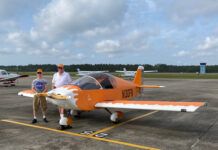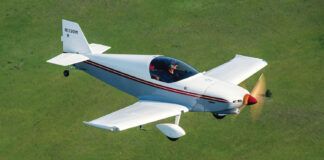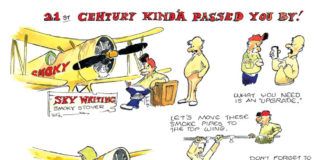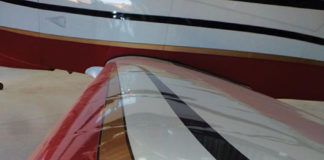Homebuilt aviation is perfect for those who like to do things over, and over, and over again. Building an airplane is nothing if not repetitious. Look, for instance, at the total number of rivets required to build a typical two-seat aluminum airplane—15,000 or so? Twice that? Every single one needs to have a hole drilled, deburred, and maybe dimpled. Remember, holes need to be deburred on both sides, and every rivet joins at least two pieces of metal, so that’s four sides to debur. And don’t think that you’ll get out of repetition by going composite; there are endless cups of resin to mix, and more sanding than you can imagine. Sand, layup, repeat. The same is true for dope and fabric, wood, or any other material you can dream up. Repetition, it seems, is good for the soul—or a ticket to purgatory.
I was thinking about this not long ago as we were preparing to build the spars for our Xenos motorglider project. A wingspar is not simply a long slab of metal to which you attach everything else. It is built up of many parts: caps, multiple web laminations, and rib attachment points. Spars are complex items that take a lot of preparation before they are ready to assemble. Working on rib attachment angles, I counted 24 different parts, half mirror images of the other half, yet nevertheless, all having to be laid out individually. Each had different dimensions, although they were cut from the same basic stock. You could mass produce the blanks to a point, but because of taper, there were enough different flange lengths to require custom marking and ripping on each one.
Then, of course, there are different hole patterns for each set, and that required making templates, traced from the master drawing, center-punching each hole, then going to the drill press to pilot drill each one. Deburring followed, and that was followed by quality control checks (placing them on the drawings to make sure everything lined up). Before I was done with all the pieces, I probably had spent five or six hours in the shop, all doing the same thing—mark, drill, debur.
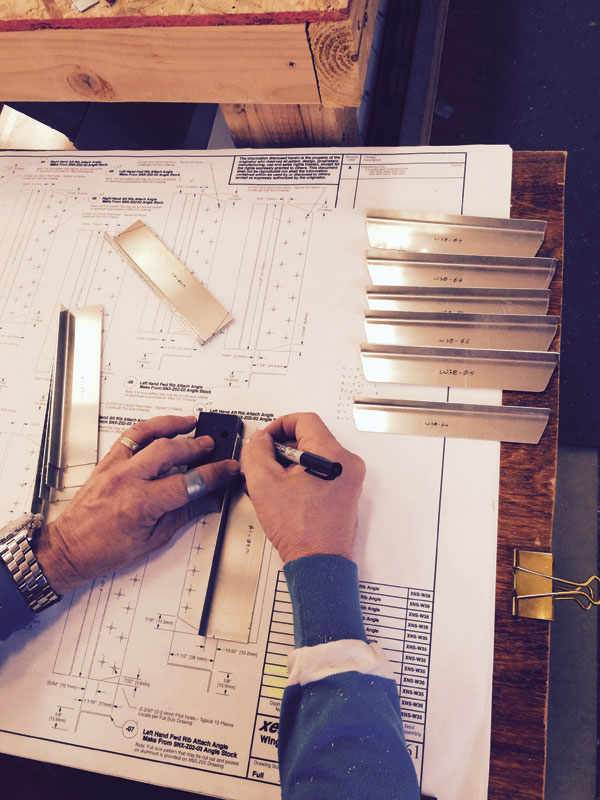
Repetition and patience is a skill that carries over from the building phase into the flying portion of a homebuilder’s life. The very best test pilots aren’t the ones willing to take the greatest gambles or risks. The best are the pilots who are able to do things exactly the same way, every time, over and over, to get the data required for the engineers. If you are flying your own Phase I, you need to fly multiple flight tests at different weights and CGs. For the data to be valid, you need to fly each flight the same for each of the various load conditions; otherwise, you’ll be comparing apples and oranges. That’s just a waste of time.
Flying the same way every time takes a certain amount of skill. But more importantly, it requires discipline—and isn’t it nice that the discipline can be learned in the building process for the airplane? All of those hours of repetition will pay off when you get into the cockpit and need to fly the same way. Don’t worry—you’ll get to have wild, undisciplined fun later on. But wait…what about the use of a checklist to make your flying career long and safe?
Listen in on a good, professional flight crew, and you’ll quickly get bored—or wonder if they aren’t just playing back a recording of an earlier flight. Checklists are used to enforce a discipline in the cockpit, and are one major contributor to the astronomically low accident rate now enjoyed by the airlines. Major airline accidents are an infinitesimally small statistical occurrence compared to the number of passenger hours flown. And a lot of that has to do with the discipline of finding the lowest risk way of doing something (like an instrument approach) and then doing it exactly the same way every time. This is a lesson that we can, and should, take to heart in the homebuilding world. More discipline—more repetition—can lower the risk of mishaps.
This emphasis on discipline can, however, lead to paradoxes, like that of the stabilized approach. Stabilized, cookie-cutter approaches are the staple of jet operations. Do it the same way, every time, hit the same altitudes at the same distances from the runway, on speed and on the desired descent rate. If you can fly precisely, the only variation is in the winds, and you can add or decrease power to compensate. That’s the pilot skill. In contrast, there is a philosophy that says that in a light plane, you should make different approaches as frequently as possible—high energy, low energy, wide, tight, long final, short final—because you never know what you are going to have to do when mixing it up with other traffic. You can fly the exact same power-off-from-low-key approach if you are the only one using the pattern at your private strip. But head to the big airport to get some fuel, and the tower might have a completely different set of instructions, and you need to be flexible.
The real difference between light singles and jets, of course, is the single engine that might fail, leaving you in a vulnerable spot if you don’t have the energy to reach the field. But guess what—if you fly IFR, you’re going to be there. If you get stuck behind a student pilot flying a large pattern—you’re going to be there. Airliners don’t often have to deal with the slow Cessna ahead of them and can fly predictably all the time, every time. In fact, you can hear the annoyance in some airline pilots’ voices when someone gets in their way. (These are usually the voices of those who don’t also have an RV or a biplane or a Cub stuck away in a hangar at their local airport for personal stress relief). I like to vary my approaches when I am flying a single so that I gain experience in being in various parts of the energy envelope. So there you have it—the repetition paradox. Is it good or bad to do it the same way every time?
Experience has shown that whether you are designing, building, training, or flying, developing good habit patterns (mark, drill, debur, dimple, Cleco…) and good repetition skills (Gas, Undercarriage, Mixture, Prop, Pump…) are good ways to lower your overall risk. Staying open to new ideas—and changing conditions—is important as well, so don’t let yourself get “stuck” in a rut; but sometimes, ruts can keep us safe. The importance, as always, is in keeping your overall situational awareness so that you know when you can put yourself on autopilot, and when you have to use a little originality.
OK—I guess I have put off drilling more holes long enough—back to the shop. Mark, drill, debur, Cleco… repeat!









